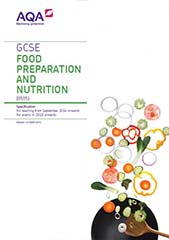3.2 Food, nutrition and health
This section requires students to demonstrate their knowledge and understanding of the following subject content:
Macronutrients
Protein
|
Content |
Students must know and understand |
Suggested application and food preparation skills |
|---|---|---|
|
|
|
Fats
|
Content |
Students must know and understand |
Suggested application and food preparation skills |
|---|---|---|
|
|
|
Carbohydrates
|
Content |
Students must know and understand |
Suggested application and food preparation skills |
|---|---|---|
|
|
|
Micronutrients
Vitamins
|
Content |
Students must know and understand |
Suggested application and food preparation skills |
|---|---|---|
|
Fat soluble
|
|
Knife skills – fillet and slice fish and/or fruits and vegetables (S2). |
|
Water soluble
|
|
|
|
Antioxidant functions of vitamins
|
The role of antioxidants in protecting body cells from damage. |
Preparing fruit and vegetables eg making different salads inclusive of vegetables, nuts or eggs which contain antioxidant vitamins (S2/S3). |
Minerals
|
Content |
Students must know and understand |
Suggested application and food preparation skills |
|---|---|---|
|
|
|
Water
|
Content |
Students must know and understand |
Suggested application and food preparation skills |
|---|---|---|
| The importance of hydration and the functions of water in the diet. |
|
Preparing fruit and vegetables, for example in soup making – scissor snip, crush, grate, peel. Make juices and smoothies (S3). |
Nutritional needs and health
Making informed choices for a varied and balanced diet
|
Content |
Students must know and understand |
Suggested application and food preparation skills |
|---|---|---|
|
|
|
Energy needs
|
Content |
Students must know and understand |
Suggested application and food preparation skills |
|---|---|---|
|
|
|
How to carry out nutritional analysis
|
Content |
Students must know and understand |
Suggested application and food preparation skills |
|---|---|---|
|
how to plan and modify recipes, meals and diets to reflect the nutritional guidelines for a healthy diet. |
how to use current nutritional information and data eg food tables, nutritional analysis software to calculate energy and nutritional value. |
Plan, make and modify dishes calculating energy and nutritional values. |
Diet, nutrition and health
|
Content |
Students must know and understand |
Suggested application and food preparation skills |
|---|---|---|
|
how diet can affect health and how nutritional needs change in relation to:
|
Select and adjust cooking process to match the recipe and take account of dietary group eg grill meat rather than fry to reduce the fat content as a high saturated fat intake is a risk factor for CHD (S1). |
